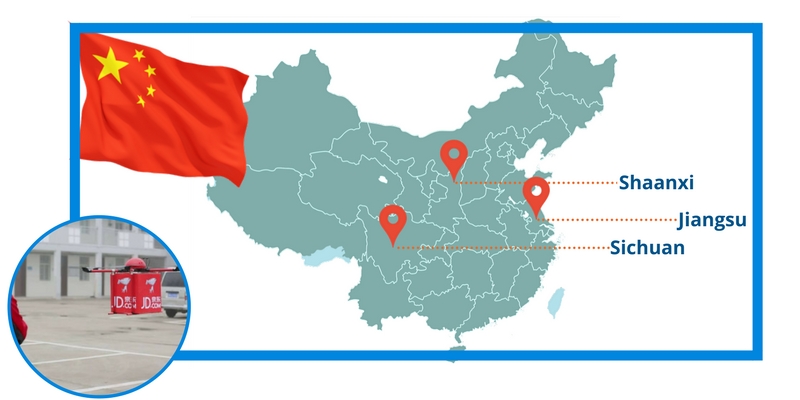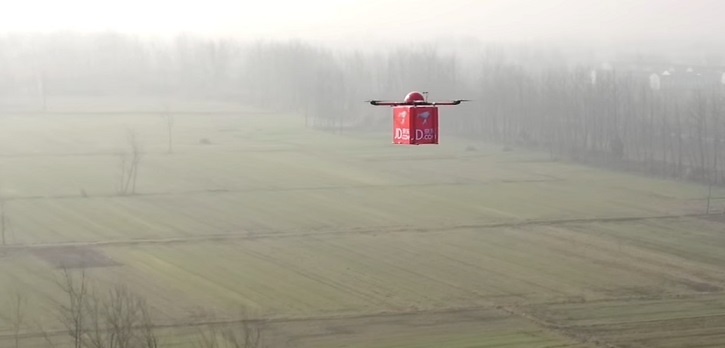China’s JD is Expanding its Drone Delivery During 2017

In the United States, drones are not scheduled to start delivery service for around 3-4 years, but it comes as no surprise to many that it is already taking place in China. Chinese company JD.com has begun the trial of its delivery service in rural areas of the nation, with test drop-off points outside of metropolis Beijing during November.
There will also have been scheduled test drops in Jiangsu, Shaanxi, and the Sichuan provinces, and the famed “Single’s Day” shopping festival is where some of the trial flights have occurred. Singles Day is the highest-grossing online retail festival on the planet, and surpasses $17 billion dollars in just a one-day period.

This is a true mile marker in the retail and technology world, as JD is firmly rooted on its way to becoming the first e-commerce company to put to use commercial drone delivery program in very large numbers. One reason why this blueprint is so far ahead of what is happening in the States is that they already have regulatory approval to fly the drones, and this year they are working to finalize approval from more local government entities across China to make their service even larger.
There are currently around 20 routes that are fixed and in the system of delivery, and by the end of this year, that number will likely jump to 100 or more. One reason that residents have been excited about the service and its future expansion is that this company’s drones can deliver orders to places where very difficult terrain and lagging infrastructure make delivery issues tougher than average.
JD has a current fleet of 30 drones, developed by their own engineers, and the focus is on delivering packages that weigh between 5 kilos and 15 kilos, covering transit distances as far as 30 miles. As just about any company that is really going the distance as far as delivery is concerned would want to, JD has its own home-grown delivery and logistics system, which is incredibly superior, and offers same and next-day delivery to an area that has a population of more than 600 million.
It was discovered that the best way to optimize this was to have each drone flying into a rural or village area carry up to 15 different packages. Then a specified delivery representative who has a high level of familiarity with the people and terrain can take them to the recipient’s address.
If a customer is in the area that is eligible for delivery, a smartphone app gives them an easy portal to order. As long as the products are readily available in the warehouse, the drone flies to the village, and leaves the package on a landing pad. Back in the United States, companies such as Amazon that are planning future delivery are embarking on the task of taking parcels to each house one by one, which customers may appreciate once full implementation is reached.
One of the most pressing issues in the United States that exists with drone delivery is regarding the FAAa: they are continuing to go through a quite long process to decide exactly what rules they will be enforcing when it comes to drone delivery. Successfully coordinating and implementing an air traffic control system that will work in low-altitudes has been another hurdle that needs to be tackled before numerous drone delivery systems roll out in the States as well.

There is a bit more than a glimmer of hope in the US, however: during November, 7-11 did a trial run of 77 deliveries by drone. Partnering up with drone company Flirtey, they successfully followed through a plan that had completion points within one mile of the store, and all remained within the line of sight of the drone operator.
The line-of-sight clause in the drone laws as they are laid out right now is another issue for the United States: since JD in China has found a way to traverse 30 miles or so, there seems to be a long way ahead in the road that needs to be paved for efficient drones deliveries to take place. FAA regulations in the United States also whittle down the possibility of efficient deliveries anytime soon with one of their provisions: commercial drones at this point cannot fly over anyone that is not directly involved in the sales transaction.
Most entities are pretty intelligent when it comes to pinpointing the types of goods that customers will be the most anxious to receive: in New Zealand last summer, Domino’s Pizza announced that they would be attempting to deliver by drone sometime during 2017. Whether it is a hot slice or happening new pair of heels that you have been dying to try on, it’s evident that we may all soon see delivery by drone, as soon as a few legal and technical kinks are willingly worked out.






